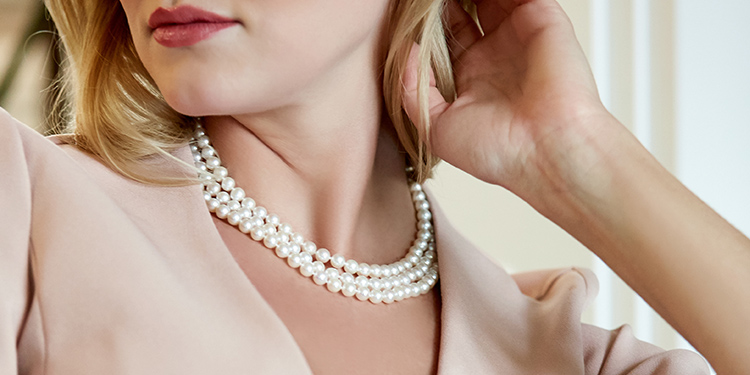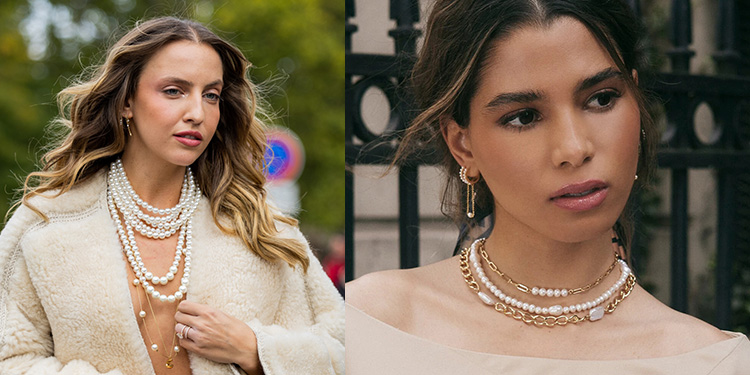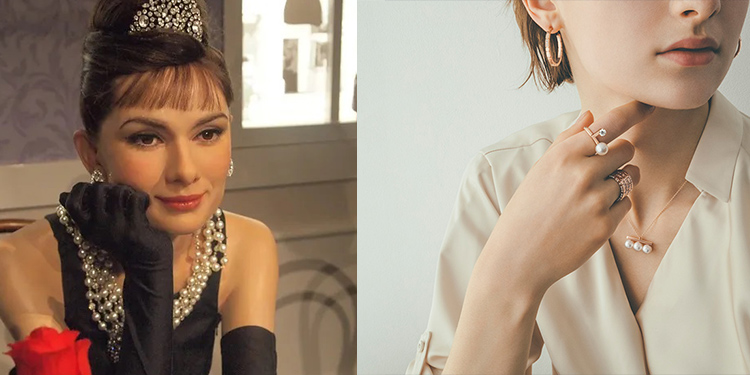Why are Pearl Necklaces the New Diamonds?

In contemporary fashion, a captivating transformation is underway as pearl necklaces emerge as the new diamonds, exuding a timeless elegance that captivates modern tastes.
Embarking on a journey through history, we find pearls deeply rooted in the annals of fashion, having been cherished by ancient civilizations like the Greeks, Romans, and Egyptians.
From these historical origins, pearls have traversed through centuries, embodying luxury and sophistication.
As fashion evolves, a resurgent trend for pearl necklaces is apparent, resonating with fashion-forward individuals seeking a distinctive allure that defies convention.
This renaissance can be attributed to the versatility of pearls, which seamlessly complement formal and casual ensembles, catering to diverse styles and occasions.

While diamonds have long been hailed as the ultimate symbol of luxury, modern sensibilities embrace the understated charm of pearls.
With their natural allure and organic origins, Pearls offer an alluring alternative to the glorious brilliance of diamonds, resonating profoundly with those seeking a refined and nuanced statement of fashion.
As we delve into the allure of pearl necklaces, we find their understated elegance reigns supreme in contemporary fashion.
The Appeal of Pearls Necklaces

Pearl necklaces possess an innate allure, drawing admirers with their natural elegance.
Unlike other gems, pearls are formed organically within oysters, giving them a unique and captivating charm.
Their subtle, iridescent glow effortlessly complements any skin tone, making them an enduring choice for fashion-conscious individuals across the globe.
One of the most appealing aspects of pearl necklaces is their unparalleled versatility.
Whether adorning an evening gown or enhancing a casual ensemble, these luminous gems exude sophistication and grace, fitting seamlessly into various occasions and styles.
From formal galas to everyday wear, pearls elevate any look with timeless elegance.
The endorsement of pearl necklaces by celebrities and influencers further solidifies their appeal.
A favorite amongst fashion icons, pearl necklaces have graced red carpets and adorn the necks of renowned figures, shining a spotlight on their enduring charm.
The Rarity and Cultivation of Pearls

The allure of pearls lies in their captivating beauty, rarity, and intricate cultivation process.
Natural pearls, formed entirely by chance within the depths of oceans and seas, are scarce, making them highly coveted treasures throughout history.
The scarcity of natural pearls can be attributed to the infrequent occurrence of oysters finding an irritant that initiates the pearl-forming process.
With the growing demand for pearls, cultured pearls have emerged as a more accessible alternative.
These pearls are cultivated through a controlled process that introduces irritants into oysters or mollusks.
Cultured pearls are of various types, such as Akoya, South Sea, and Tahitian, each distinguished by size, shape, and luster.
Pearl cultivation techniques have evolved significantly, embracing sustainable practices to protect marine ecosystems.
Ethical pearl farming involves carefully monitoring water quality, responsible harvesting, and supporting the oyster populations' well-being.
As a result, contemporary pearl cultivation strikes a balance between meeting demand and preserving these precious gems for generations to come.
Historical Significance of Pearls and Royalty

Throughout history, pearls have stood as compelling symbols of wealth and power, tightly interwoven with the lives of royalty and nobility.
For centuries, pearls have adorned the crowns, sceptres, and regal attire of kings, queens, and emperors.
From the ancient rulers of Egypt and Mesopotamia to the majestic courts of Europe, pearls were treasured as a mark of luxury and prestige.
Cleopatra's fondness for pearls was legendary in the classical world, showcasing her unrivalled status.
The allure of pearls also found resonance in European royalty during the Renaissance and Baroque eras, as they graced the necks of queens and princesses, enhancing their regal aura.
Notable among the famous pearl necklaces owned by royalty is the "La Peregrina," an extraordinary pearl discovered in the Americas and gifted to Queen Mary I of England, further enhancing her stature.
Moreover, the "Queen Mary Pearl Necklace," with its four rows of lustrous pearls, exemplified the grandeur of British royalty.
In modern times, while pearls symbolise sophistication and elegance, designers have sought to reimagine classic pearl designs, blending tradition with contemporary aesthetics.
This metamorphosis has led to avant-garde pearl creations, appealing to a diverse range of fashion-conscious individuals, proving that the allure of pearls and their connection to royalty persist as a cherished aspect of the ever-evolving world of jewelry and fashion.
The Evolution of Pearl Jewelry Designs

The evolution of pearl jewelry designs is a captivating journey that spans centuries, showcasing the enduring charm of these lustrous gems in fashion.
In the annals of history, traditional and classic pearl necklace styles have reigned supreme, adorning the necks of royalty and aristocracy alike.
These timeless designs, characterized by uniform pearl strands, have epitomized elegance and sophistication for generations.
However, as fashion has evolved, so too have pearl jewelry designs.
Contemporary and innovative styles have emerged, reflecting the changing tastes of modern consumers.
From asymmetrical arrangements to unique color combinations and mixed media, designers have pushed the boundaries of pearl jewelry, infusing it with newfound versatility and artistic expression.
The influence of visionary fashion designers cannot be underestimated in this evolution.
Their bold experimentation and reinterpretation of pearl jewelry have breathed new life into these organic treasures, captivating younger generations and rekindling the interest of connoisseurs.
As a result, pearl necklaces today stand as a testament to the allure of tradition, seamlessly entwined with the creativity and ingenuity of contemporary design.
Pearl Symbolism and Cultural Significance

P pearls have held profound symbolism and cultural significance throughout various cultures and traditions.
These lustrous gems have been revered as symbols of purity, wisdom, and spiritual transformation.
In many ancient societies, pearls were considered celestial gifts from the gods or tears of the divine.
Their spherical shape also represents harmony and unity.
Pearl-adorned jewelry features prominently in sacred rituals, symbolizing prosperity, protection, and good fortune.
From the East to the West, pearls have been entwined into folklore and myths, embodying virtues that transcend time.
This enduring allure has established pearls as more than just jewels; they encapsulate a deep-rooted cultural heritage and a potent representation of meaningful symbolism.
The Influence of Celebrities on Pearl Trends

The influence of celebrities on pearl trends has been profound, with red carpets and high-profile events becoming platforms for showcasing the allure of pearl necklaces.
As stars don these elegant gems, their popularity soars among fashion-conscious individuals.
Social media is pivotal in disseminating celebrity fashion choices in the digital era, further fueling the pearl jewelry trend.
An influential post or appearance can spark a viral sensation, driving demand for pearl necklaces.
Endorsements by celebrities also play a significant role, with their association enhancing the desirability of pearls in the eyes of consumers, solidifying their position as a coveted and iconic fashion accessory.
Investing in Pearl Necklaces

Investing in pearl necklaces can be a tricky and rewarding venture.
High-quality pearls possess significant value and investment potential, particularly those with exceptional luster, surface quality, and size.
When seeking pearls with good investment potential, look for size, shape, surface quality, shade, and shine.
Additionally, collecting vintage and rare pearl necklaces can be a lucrative strategy.
Historical significance, provenance, and unique designs contribute to their desirability among collectors and investors.
As demand for exquisite pearls persists, investing in these timeless treasures can yield substantial returns.
Mythbusting Pearl Misconceptions

In the realm of precious gems, pearls have garnered a myriad of myths and misconceptions.
It is essential to debunk these fallacies to appreciate these exquisite gems' true beauty and value.
One common misconception revolves around pearl farming, with some believing that pearls are harvested from oysters in significant quantities, depleting natural populations.
However, modern pearl farming practices promote sustainable methods, ensuring oyster populations remain healthy.
Moreover, another myth suggests that natural pearls are superior to cultured pearls, but this is subjective as both possess unique allure.
By educating consumers about the intricacies of pearl cultivation, we empower them to make well-informed decisions, embracing the timeless elegance of pearls without being swayed by misconceptions.
Summary: The Reign of Pearls

In contemporary fashion, pearl necklaces are experiencing a renaissance, becoming the new diamonds for modern tastes.
Their innate allure, organic origins, and versatility make them a coveted choice for fashion-forward individuals.
The historical significance of pearls, symbolizing wealth and power, further adds to their timeless charm.
Pearl jewelry designs have evolved, blending tradition with innovation.
Additionally, pearls hold profound symbolism and cultural significance worldwide.
Celebrities' influence on pearl trends has catapulted their popularity, while debunking misconceptions about pearl farming help consumers make informed decisions.
In summary, pearl necklaces encompass elegance, versatility, and enduring allure, making them a cherished and meaningful addition to contemporary fashion.
FAQs About Pearl Necklaces

Answering common questions about pearls and pearl necklaces.
Here are some common questions about pearls and pearl necklaces:
1. What are pearls made of?
Pearls are formed inside oysters and mollusks when an irritant gets trapped, and the mollusk secretes layers of nacre around it, creating a pearl.
2. Are pearls expensive?
The cost of pearls varies depending on size, shape, and luster.
Natural pearls are rare and costly, while cultured pearls offer a more accessible option.
3. How do I care for pearl necklaces?
To maintain the luster of pearl necklaces, avoid exposing them to harsh chemicals, perfumes, or direct sunlight.
Clean gently with a soft cloth after wearing to remove any residue.
Providing insights into choosing the right pearl necklace.
When selecting the perfect pearl necklace, consider type, size, and luster.
Opt for well-matched pearls with a smooth surface.
Check uniformity in color and secure clasps.
Dispelling doubts and uncertainties about pearl jewelry.
This concise article aims to dispel doubts and uncertainties surrounding pearl jewelry.
By addressing misconceptions and highlighting their enduring appeal, we shed light on the elegance and value of pearls, providing reassurance to those considering these timeless gems for their adornment.


Leave a Comment